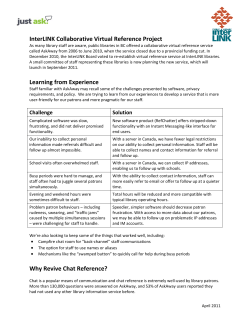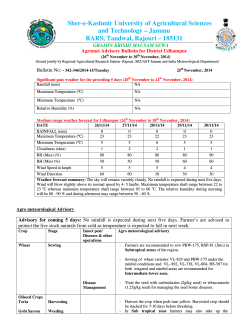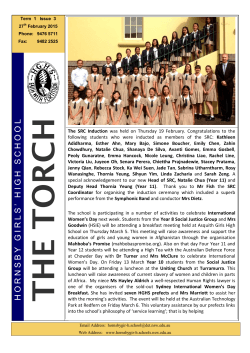
Weeding! - Evergreen Indiana
WEEDING! Evergreen Indiana Annual Conference 2015 Jocelyn R. Lewis Indiana State Librar y THE GOAL OF THIS PRESENTATION IS TO: 1 • Highlight the benefits of effective weeding both for individual libraries and the consortium as a whole. 2 • Demonstrate how to use the reports module to help identify weed candidates in your collection. 3 4 5 • Provide and overview of common weeding techniques. • Give examples of the types of books to consider weeding from your collection. • Provide suggestions on what to do with weeded materials. Why Weed? “There’s a reason we use the term ‘weeding’ to describe the act of discarding books. Gardeners do it to get rid of the weeds that hamper the growth of the healthy plants. Weeds take up a lot of valuable nutrients that the other plants (or books, if you’re following the analogy) could use to thrive. Weeding is love! Take care of your collection.” -- Collier (2010) WHY WEED? There is not enough shelf space in your library to house every title you have ever owned. WHY WEED? There is not enough shelf space in your library to house every title you have ever owned. Your patrons deserve access to materials that contain current and accurate information. WHY WEED? There is not enough shelf space in your library to house every title you have ever owned. Your patrons deserve access to materials that contain current and accurate information. A well-weeded collection tends to circulate more items. WHY WEED? There is not enough shelf space in your library to house every title you have ever owned. Your patrons deserve access to materials that contain current and accurate information. A well-weeded collection tends to circulate more items. Tidy shelves that are not crammed full of items make it both easier for staf f and patrons to locate materials. WHY WEED? There is not enough shelf space in your library to house every title you have ever owned. Your patrons deserve access to materials that contain current and accurate information. A well-weeded collection tends to circulate more items. Tidy shelves that are not crammed full of items make it both easier for staf f and patrons to locate materials. Each obsolete or unused item has a correlating bib record in the catalog which we will pay for when we want to perform a batch process on all records ( eg. implementing authority work). These records also make basic catalog maintenance dif ficult. WHY WEED? There is not enough shelf space in your library to house every title you have ever owned. Your patrons deserve access to materials that contain current and accurate information. A well-weeded collection tends to circulate more items. Tidy shelves that are not crammed full of items make it both easier for staf f and patrons to locate materials. Each obsolete or unused item has a correlating bib record in the catalog which we will pay for when we want to perform a batch process on all records ( eg. implementing authority work). These records also make basic catalog maintenance dif ficult. You’re in a huge consortium! Your patrons have access to the materials at other libraries so you don’t need to worry about providing EVERY THING on your own! Why Weed? “Remember that your library is not a museum – there is simply not enough space (nor is it our mission) to be a warehouse of unused books.” -- Vnuk (2012) How to weed “It’s hard to discard the picture book you adored as a child, or the atlas donated in memory of Mrs. Jones. But our libraries exist to fill today’s needs, not those of ten or 20 years ago. Train yourself to follow seriously objective criteria, such as the last checkout date.” -- Young (2009) HAVE AN OFFICIAL WEEDING POLICY The Evergreen Indiana Membership Agreement (Section III) stipulates: o) Develop and adhere to a weeding [purging] plan prior to retrospective conversion and request a waiver for any items that are kept and not entered into the database. r) Maintain standards and practices of collection development and not reduce acquisitions by reliance upon the collections of other participating Evergreen Indiana libraries. HAVE AN OFFICIAL WEEDING POLICY A weeding plan should be part of your overall Collection Development policy. A well -constructed policy will: --Specifically spell out your criteria for weeding thus providing a guideline for your library to adhere to. --Explain why weeding is necessary. --Explain how materials will be disposed. --Provide protection for patron or community backlash to weeding projects. HOW TO EVALUATE USING OBJECTIVE CRITERIA How many times has it circulated?* When was the last time it was checked out?* When was the book published?* *Hint: Evergreen can answer these questions for you! HOW TO WEED USING EVERGREEN REPORTS Want to see circ stats for every item in a particular shelving location? Reports/Shared Folders/Templates/ isl jasonb/Shared Templates (EG-IN)/Items (EG-IN)/Item Details, Including Total Circs and Last Circ Date by Shelving Location Want to know w hat items in your building never have circulated? Reports/Shared Folders/Templates/ isl jasonb/Shared Templates (EG-IN)/Items (EG-IN)/List Items Never Circulated Looking for a list of items that haven’t circulated since a specific date? Reports/Shared Folders/Templates/ isl jasonb/Shared Templates (EG-IN)/Items (EG-IN)/Selection Criteria For Items Not Circulated Since Date SUBJECTIVE WEEDING …USING ACRONYMS! Once you’ve located potential candidates for discard, implement the MUST Y method! For each title, evaluate based on the following: SUBJECTIVE WEEDING …USING ACRONYMS! Once you’ve located potential candidates for discard, implement the MUST Y method! For each title, evaluate based on the following: Misleading – Is the information in the book accurate? SUBJECTIVE WEEDING …USING ACRONYMS! Once you’ve located potential candidates for discard, implement the MUST Y method! For each title, evaluate based on the following: Misleading – Is the information in the book accurate? Ugly – Is the book excessively worn, stained or smelly? SUBJECTIVE WEEDING …USING ACRONYMS! Once you’ve located potential candidates for discard, implement the MUST Y method! For each title, evaluate based on the following: Misleading – Is the information in the book accurate? Ugly – Is the book excessively worn, stained or smelly? Superseded – Are there newer and better copies available? SUBJECTIVE WEEDING …USING ACRONYMS! Once you’ve located potential candidates for discard, implement the MUST Y method! For each title, evaluate based on the following: Misleading – Is the information in the book accurate? Ugly – Is the book excessively worn, stained or smelly? Superseded – Are there newer and better copies available? Trivial – Is it valuable or important to your patrons? SUBJECTIVE WEEDING …USING ACRONYMS! Once you’ve located potential candidates for discard, implement the MUST Y method! For each title, evaluate based on the following: Misleading – Is the information in the book accurate? Ugly – Is the book excessively worn, stained or smelly? Superseded – Are there newer and better copies available? Trivial – Is it valuable or important to your patrons? Your collection – If there is no use for the book, it is irrelevant to your collection. MORE WEEDING WITH ACRONYMS! Or try implementing CREW! This is more of a holistic approach which embeds weeding as a part of the overall everyday functions of the library. MORE WEEDING WITH ACRONYMS! Or try implementing CREW! This is more of a holistic approach embeds weeding as a part of the overall everyday functions of the library. Continuous Review – De-selection of materials is as continuous a process as selection. MORE WEEDING WITH ACRONYMS! Or try implementing CREW! This is more of a holistic approach embeds weeding as a part of the overall everyday functions of the library. Continuous Review – De-selection of materials is as continuous a process as selection. Evaluation – Habitually run reports and analyze the performance of materials in your collection. MORE WEEDING WITH ACRONYMS! Or try implementing CREW! This is more of a holistic approach embeds weeding as a part of the overall everyday functions of the library. Continuous Review – De-selection of materials is as continuous a process as selection. Evaluation – Habitually run reports and analyze the performance of materials in your collection. Weeding – Consistently remove items from the collection. CREW manual available at https://www.tsl.texas.gov/ld/pubs/crew/index.html What to weed “Realistically every item must ‘earn’ its place in a library’s collection. If a library is full of old, worn, outdated materials, who wants to use it? If a library’s shelves are full of books to the point of overload, what case can really be made for buying more?” -- Rogers (2007) Note: Many of the examples from this section come from the Awful Library Books blog (http://awfullibrarybooks.net/). While some of these titles are in the Evergreen catalog, not all are. The goal of this section is to highlight examples of items that should be considered for weeding and not to put a negative spotlight on any particular library or its collection! Issue: Outdated information – Health books These are titles you should consider weeding because much of the medical data held within is obsolete. It can be dangerous to continue making these titles available to your patrons. Inaccurate data can lead to poor decision making! 1985 1985 1985 1978 Issue: Outdated information – Technology books Rapid changes in technology mean you really need to keep on top of these titles! Consider removing titles for obsolete computer and gaming systems. Anything published prior to 2000 should definitely be a high priority for withdrawing. Even books published in the early 2000s can be outdated! Beware! this book maymay looklook OK, ifOK, youifopen you will seewill thatsee all of Beware!While While this book you itopen it you the screenshots are of Netscape a nowNavigator, largely defunct web that all of the screenshots areNavigator, of Netscape a now browser. largely defunct web browser. Issue: Outdated information – Student resources Many school children and teenagers come to your library looking for sources to use for school assignments. Make sure they leave your building with quality titles containing accurate information. This will make them more likely to become lifelong library patrons. Not even a country anymore!!!! Issue: Outdated information – Travel Guides Travel guides need to be replaced pretty frequently as hotels, restaurants and tourist attractions change constantly. For example, a London travel guide published prior to 2000 won’t even mention the London Eye which is by far the most popular paid tourist attraction in the entire UK. Issue: Excuse me, your 15 minutes of fame are UP Like technology, celebrity culture changes at a rapid pace. The people who are newsworthy and notable one year tend to lose their allure over time. Consider removing titles for outdated celebrities in order to make room for today’s newsmakers! Issue: Offensive (or potentially offensive) Call it “political correctness” or call it a natural evolution of social norms but some older books contain cringe-worthy language and images. Consider pulling these before a patron launches a complaint. Issue: Fads of the past Sure, macramé might see a resurgence someday and when that day comes people still won’t want to check out your how-to manuals from the 1970s. Kitsch appeal only goes so far….. Issue: Just plain weird It’s amazing that these A) ever got published and B) were purchased by numerous public libraries throughout the country and C) can still be found in some collections. If they aren’t circulating, let them go. Issue: Local authors, community histories , memorial books A big concern is what to do with materials that have a strong connection to your community. Maybe the book is by a local author….but it doesn’t circulate. Or it was donated by someone in the community twenty years ago….and it hasn’t circulated in ten years. You DON’T have to keep these. You can try offering them up on a listserv. The State Library is interested in Indiana-related materials that we don’t already have in the collection. Another library or institution that collects local history items might also be happy to have them. No, you really don’t have to keep those self-published books with the awkward covers. If they aren’t circulating, consider removing them. Issue: Condition If a book is stained, falling apart and/or has a musty smell, remove it from your collection. Stains and musty smells can indicate mold and mold can easily spread from one book to another while also posing potentially serious health risks to your patrons. If it’s a popular book, replace it with a newer edition. Why Weed? “Afraid that if you get rid of a book, someone will ask for it tomorrow? The truth is that rarely happens. It is much more likely that you will be asked for a title that you decided not to buy in the first place” -- Young (2009) Weeding -- The Honeymoon Period (or, What to Do With All Those Old Books) WHAT TO DO WITH ALL THOSE WEEDED BOOKS? MAKE MONEY! •Booksales •Offer materials to other libraries via listservs. •Offer materials to nursing homes, retirement centers, women’s shelters, prisons, etc. •Better World Books – Donated library books are resold and you get money for each sale. All money raised by this company is used to support literacy programs and libraries. Bonus: It’s an Indiana-based company (Mishawaka). (http://www.betterworldbooks.com/go/libraries) •Gotlibrarybooks.com (aka Thriftbooks) – Sells discarded library books on your behalf. WHAT TO DO WITH ALL THOSE WEEDED BOOKS? MAKE ART!!!! For books that aren’t worth selling or donating, use them for a fun project. There are endless things you can make with books! A simple Pinterest search will yield all sorts of ideas. Bibliography •Collier, Ginny (2010). The reluctant weeder: embracing the joy of weeding. Children and Libraries, 8(2), 51-53. •Dilevko, Juris & Lisa Gottlieb (2003). Weed to achieve: a fundamental part of the public library mission? Library Collections, Acquisitions, & Technical Services, 27, 7396. •McCormack, Nancy (2008). When weeding hits the headlines: how to stop your library from making (that kind of) news. Feliciter, 54(6), 277-278. •McEwen, Ian (2012). Separating the wheat from the chaff. Teacher Librarian, 39(4), 33-34. •Rogers, Terri (2007). Weeding: bringing a great practice to light. PNLA Quarterly, 71(2), 8-9. •Vnuk, Rebecca (2012). Weeding tips: the basics. Booklist Online, Februrary 12, 2012. •Young, Diane J. (2009). Guide to effective weeding. Library Journal, 134(19), 36. Additional resources •Weeding library collections: A selected annotated bibliography for library collection evaluation This ALA resources is available online at: http://www.ala.org/tools/libfactsheets/alalibraryfactsheet15 •Weeding the library collection This one hour webinar is available via WebJunction at: http://learn.webjunction.org/course/index.php?categoryid=8 •CREW: A weeding manual for libraries An updated version of the CREW manual created by the Texas State Library and Archives Commission is available for free at: https://www.tsl.texas.gov/ld/pubs/crew/index.html AS ALWAYS, THANK YOU FOR YOUR EFFORTS AT ENSURING THAT EVERGREEN INDIANA MAINTAINS A HIGH QUALITY CATALOG! Questions? Jocelyn R. Lewis – jlewis2@library.in.gov
© Copyright 2025









